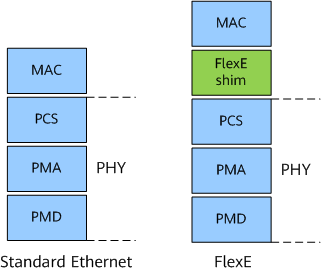Overview of FlexE
Definition
Flexible Ethernet (FlexE) is an interface technology that implements service isolation and network slicing on a bearer network. Based on the standard Ethernet technology defined in IEEE 802.3, FlexE decouples the MAC layer from the PHY layer by adding a FlexE shim layer between them (for its implementation, see Figure 1). With FlexE, the one-to-one mapping between MACs and PHYs is not a must any more, and M MACs can be mapped to N PHYs, thereby implementing flexible rate matching. For example, one 100GE PHY can be divided into a pool of twenty 5 Gbit/s timeslots, and service interfaces can flexibly apply for separate bandwidth from this pool.
Purpose
The need for higher mobile bearer bandwidth is increasing as 5G networks continue to evolve. In addition, customers want a unified network to transmit various services, such as home broadband, private line access, and mobile bearer services. These factors place increasingly higher requirements on telecommunication network interfaces.
When standard Ethernet interfaces are used as telecommunication network interfaces, the following issues exist:
- More flexible bandwidth granularities are not supported: Diverse services and application scenarios require Ethernet interfaces to provide more flexible bandwidth granularities without being restricted by the rate ladder (10 Gbit/s–25 Gbit/s–40 Gbit/s–50 Gbit/s–100 Gbit/s–200 Gbit/s–400 Gbit/s) defined by IEEE 802.3. It may take years for IEEE 802.3 to define a new interface standard, which cannot meet the requirements of application changes. Furthermore, formulating an interface standard for each bandwidth requirement is impossible, and therefore other interface solutions are required.
- The Ethernet interface capability of IP devices depends on the capability of optical transmission devices, and their development is not synchronous: For example, optical transmission devices do not have 25GE or 50GE interfaces. However, when IP and optical transmission devices are interconnected, the link rate of the optical transmission device must strictly match the Ethernet rate of the corresponding User-to-Network Interface (UNI).
- Enhanced QoS capability for multi-service bearing is not supported: Standard Ethernet interfaces perform scheduling based on QoS packet priorities. As a result, long packets will block the pipe, increasing the latency of short packets. In this case, services affect each other.
FlexE resolves these issues by:
- Supporting more flexible bandwidth granularities: FlexE supports the flexible configuration of interface rates, which may or may not correspond to the interface rates defined in the existing IEEE 802.3 standard. This meets the requirement for diverse services and application scenarios.
- Decoupling from the capability of optical transmission devices: The Ethernet interface rate of IP devices is decoupled from the link rate of optical transmission devices, meaning that the link rate of optical transmission devices does not need to strictly match the Ethernet rate of a UNI. In this way, the existing optical transmission network (OTN) can be utilized to the maximum extent to support Ethernet interfaces with new bandwidths.
- Supporting the enhanced QoS capability for multi-service bearing: FlexE provides channelized hardware isolation on physical-layer interfaces to implement hard slicing for SLA assurance and isolated bandwidth for services.
